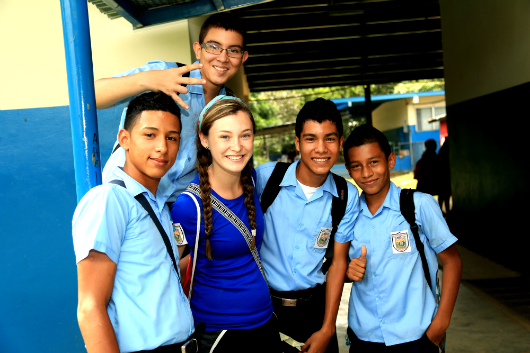
In order to fully comprehend poverty on a global scale, one first must understand how it affects his or her own backyard.
The only way to do that is to go out into a community, talk to members of that community and volunteer. Local volunteer work serves as the stepping stone to understanding the root causes of poverty at home and around the world.
Stacie Nevadomski Berdan and husband Marshall Berdan, authors of the book “Raising Global Children,” highlight the importance of introducing American teenagers to the world of service.
According to their book, the local service teenagers perform allows them to “develop key life skills such as empathy, compassion, negotiation skills, teambuilding and communication.” Similar skills are needed to work with people across all cultures in different situations.
There are some nationally-renowned organizations in the United States that are always searching for volunteers, especially from the middle and high school demographics. Participating in the local chapters of some of these organizations can be a springboard to completing international service trips, mission trips or even internships with NGOs.
Habitat for Humanity – With more than 1,400 chapters around the U.S., Habitat for Humanity is one of the largest nonprofit organizations in the country. For high school students, it means there are a plethora of opportunities close to home to help build a home for someone in need. Habitat also has a presence in more than 70 countries around the globe, making this organization a nice transition for students who want to do service abroad with an organization they recognize.
Girl Up – The United Nations Foundation created this campaign in order to equip and empower young women to fight for the rights of other women around the world. There are 750 Girl Up clubs across thirty-five states and forty-five countries. Anyone can start a club using the Girl Up guide, begin to advocate for women’s rights, educate about the plight of women around the world and fundraise for U.N. projects and their partners.
Boys and Girls Club of America – The BCGA was founded to provide after-school activities, tutoring, leadership training and life skills programs to students who come from impoverished areas of the U.S. without a safe place to go when the final bell rings. There are 4,000 clubs around the country with opportunities to mentor young students, to tutor or to help run camps and other activities.
Feeding America – This organization is the leader in alleviating hunger in the U.S. It is a network of food pantries that help feed more than 46 million Americans who suffer from varying degrees of hunger. The Feeding America website has an easy-to-use navigation system to find the closest food pantry. Volunteer opportunities are not limited to serving meals or packaging. Volunteers also help deliver meals, work “farmers’ markets” and grocery stores, and tutor.
Salvation Army – The Salvation Army touches upon almost every kind of service. They work with veterans, freed prisoners looking to get back on their feet and families without homes or food. They, too, have an international component. Volunteers can choose to sponsor Salvation Army projects and kids in need around the world.
By participating in service on a regular basis, high school students can expand their world view and begin to grasp what poverty must be like outside of the wealthiest country in the world. This profound realization will make them want to help not just those within their neighborhood, but also fellow human beings.
– Morgan Abate
Sources: The Salvation Army, Feeding America, Boys and Girls Club of America, Girl Up, Habitat for Humanity
Photo:Flickr


